This past weekend marked not just the World Championships but the 2024 Grand Narrative – the largest single Crusade event in the world. This year’s event was particularly noteworthy not just for its size and dual-location split but also this being the first year the event featured new, bespoke rules written by the Games Workshop rules studio. In this article we’re going to reveal and review those rules, while next week we’ll talk about how you can use them and some suggested fixes to shore up some of their rougher spots.
If you’re looking for the rules, they released them online during the event – you can find them here.
What Was New at the 2024 Grand Narrative?
This year’s Grand Narrative featured four key new sets of rules:
- An updated Game Setup/Pregame Sequence for Crusade Missions played in Kessandras
- A new set of Battle Traits
- A new set of Crusade Relics
- Six new missions, designed to be played in order
The Pregame Sequence
As with Leviathan and Pariah Nexus, Kessandras featured an updated pregame sequence. This included a small number of significant quality of life improvements based on recent competitive pack changes. The biggest changes from Pariah Nexus Crusade Missions are:
- There is no set of rules for Pregame Requisition use, Crusade Blessings, or Agenda selection. This feels like a pretty rough oversight, and we’d recommend just going ahead and including these when you play Kessandras games.
- TITANIC units count as two drops in deployment
- Rules for Actions have been added here – these are identical to the rules in Pariah Nexus
- VP are capped at 100 points
- Redeploy abilities are now listed as a step before the first turn
Outside the first bullet – which again, feels like an oversight since it removes Agendas from Crusade and that definitely wasn’t how anyone was playing at the event – these are solid improvements that bring in some good balance fixes for Crusade games. It’s worth incorporating these into your games if you’re still using Pariah Nexus or Leviathan, and replacing the “proto-actions” rules (i.e. the “you can do this if you are eligible to shoot” templating) with formal Actions is worth doing as well.

Battle Traits
There are six Battle Traits in the Kessandras pack, and notably they can go on any unit. We’ll come back to that in a moment. The traits are:
- Martial Experience. When you gain this trait, select either ranged weapons or melee weapons. Then pick one of [LETHAL HITS], [PRECISION], or [SUSTAINED HITS 1]. Weapons of the type you picked in this unit gain the chosen ability.
- Hunters of the Trail. Models in this unit have the Scouts 6″ ability.
- Rapid Manoeuvres. At the end of your opponent’s turn, if this unit is not within Engagement Range of one or more enemy units and is wholly within 9″ of one or more battlefield edges, you can remove it from the battlefield and place it into Strategic Reserves.
- Countermeasures. This unit has the Benefit of Cover against ranged attacks.
- Accurate Strikes. Re-roll Wound rolls of 1 made for attacks with this unit.
- Aggressive Positioning. This unit can re-roll Advance and Charge rolls.
These are some good abilities. Very good, in fact. It’s actually a problem that you can take them on any unit. Martial Experience is particularly an issue, because it can be used to give an entire unit the [PRECISION] rule on all of its ranged weapons, something which could previously only occur on a single model’s weapon via a Weapon Upgrade or a single weapon on a single character via something like Treasure of the Technomandrites. If you’re curious about how this can be a problem, I’d direct your attention to the possibility of six-model Eradicator units with Precision who can just delete any character out of any squad without breaking a sweat. Or some Retributors. Or a Baneblade, Rogal Dorn, or Repulsor Executioner. I generally believe that being able to give units precision is a mistake but at least with weapon modifications it doesn’t apply to the entirety of a unit’s weapons.
Rapid Manoeuvres is also pretty dangerous, letting any unit with Deep Strike continually drop back onto the table if they choose to stay near the table edge. And letting any unit have access to Scouts 6″ is another major problem, suddenly turning a large number of slower units into turn 1 charges. We generally think having a fully generic, “any unit” table like this is a mistake, but if the idea is that it’s just one event, the novelty can carry it.
The Crusade Relics
In addition to six Traits, the rules pack for the event included nine Crusade Relics: Four Artificer, Three Antiquity, and two Legendary. These more or less continue the trend of being very strong compared to what you normally can get, typically applying to the entire unit.
Artificer Relics
- Kinetic Dampener. Attacks made against the bearer’s unit get -1 to wound if the Strength of the Attack is bigger than the unit’s Toughness.
- High-Powered Munitions. Add 6″ to the range of non-Torrent Ranged weapons equipped by models in the bearer’s unit.
- Archaeotech Omniscan. When making attacks, the bearer’s unit can ignore modifiers to BS, WS, hit, or wound rolls.
- Neural Transmitter Node. Once per battle Round, the bearer’s unit can use a Stratagem for 1 CP less than normal.
Antiquity Relics
- Translocator Matrix. Each time the bearer’s nit advances, don’t make an advance roll, instead until the end of the phase add 6″ to the bearer’s unit’s Move characteristic, and if it makes a Normal, Advance, or Fall Back move it can move through terrain and models horizontally.
- Gaol of Malice. Each time an attack is allocated to a model in the bearer’s unit, subtract 1 from the Damage characteristic.
- Exo-Tremor Sigil. Each time the bearer’s unit makes a charge move, pick an enemy unit in Engagement Range of the bearer and roll a D6; on a 2-3, that enemy unit takes D3 mortal wounds, on a 4-5 they take 3, and on a 6 they take D3+3 mortal wounds.
Legendary Relics
- Morphic Blade. The bearer’s melee weapons gain the [ANTI-INFANTRY 3+], [ANTI-MOUNTED 3+] and [DEVASTATING WOUNDS] abilities.
- Immaterial Disintegrator. Each time a model in the bearer’s unit makes an attack that targets a MONSTER or VEHICLE unit, add 1 to the wound roll.
These are all insanely good, even at the Artificer level. Kinetic Dampener is amazing on tougher models like terminators and likewise so is Gaol of Malice, which can be stacked with other damage reduction abilities to make some truly oppressively tough defensive units. That’s good if you’re using these because the Morphic Blade is an absolutely insane upgrade on multi-damage weapons. On the whole, I’d suggest these are overpowered by quite a bit compared to the standard options we saw in Codexes, Leviathan, and Pariah Nexus. Take for example the Noctic Shield Legendary Relic in Pariah Nexus, which gives your character +1 damage and wounds and a once-per-game ability to reduce incoming damage by 1 for your unit if you’re in the Defensive Strategic Footing. Or compare Kinetic Dampener up there to the Armour of the Soulless Sentry Artificer Relic in Pariah Nexus, which gives only the bearer a +1 to their toughness and save characteristics.
The Missions
There were six missions – with some twists – created exclusively for the Grand Narrative. These are, on the whole, pretty wild – though that’s not necessarily a good thing. They do some things we haven’t seen before, especially in tenth edition, and if you’re looking for some Crusade missions that don’t rely on Leviathan or Pariah Nexus mechanics, these are your only option.
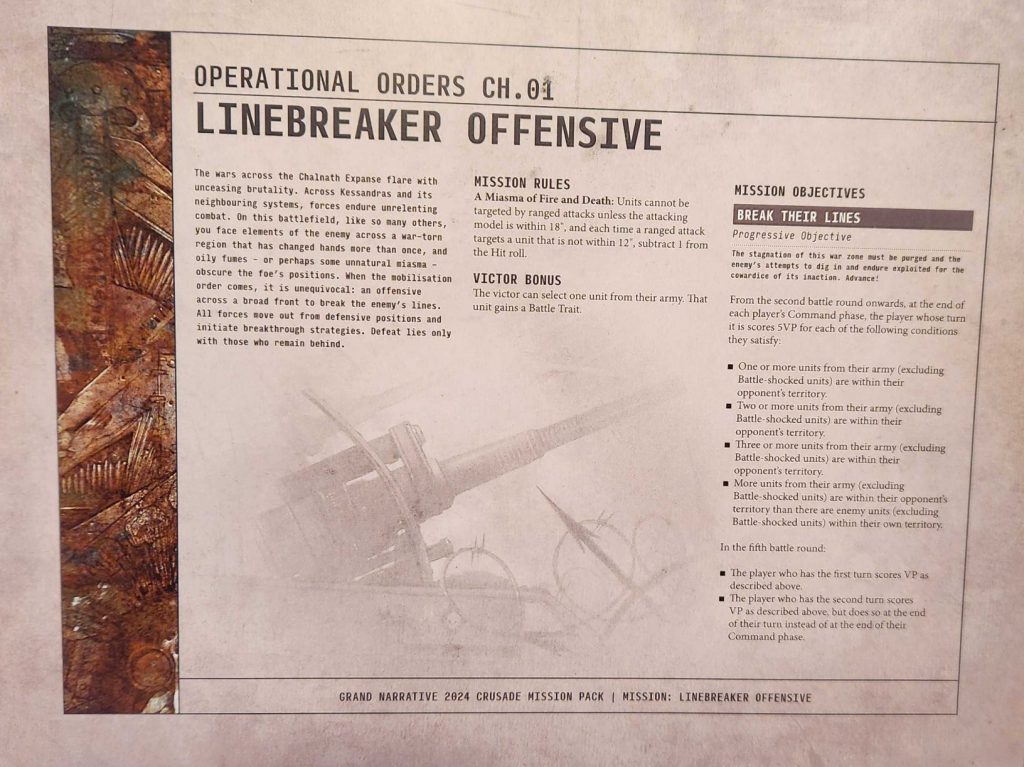
1. Linebreaker Offensive
This is by far the simplest of the missions in the pack – Players deploy in Dawn of War fashion 20″ apart, with the objective of getting onto your opponent’s half of the table – starting in the second round, you’ll score 5 VP for each unit in your opponent’s territory, up to 15 VP, plus 5 if you have more than the opponent has in yours. There’s a mission rule here that makes enemy units untargetable outside of 18″, with -1 to hit if you’re outside 12″, and that helps balance against the need to get closer. This mission is kind of OK but note that it doesn’t include any objective markers, and that tends to turn off a number of rules in player armies and Detachments.
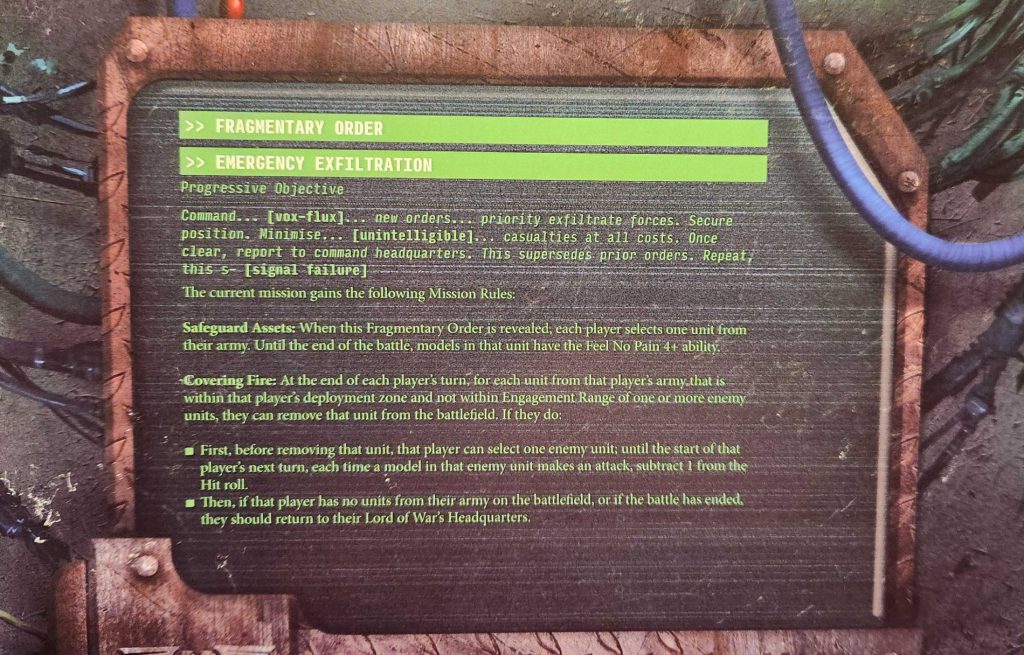
It’s worth noting that there was a second “Fragmentary Order” issued mid-game at the event, giving you a rule to remove units from the battlefield via your deployment zone. But this particular rule has no impact on scoring or mission objectives, and I’d strongly recommend just ignoring it.
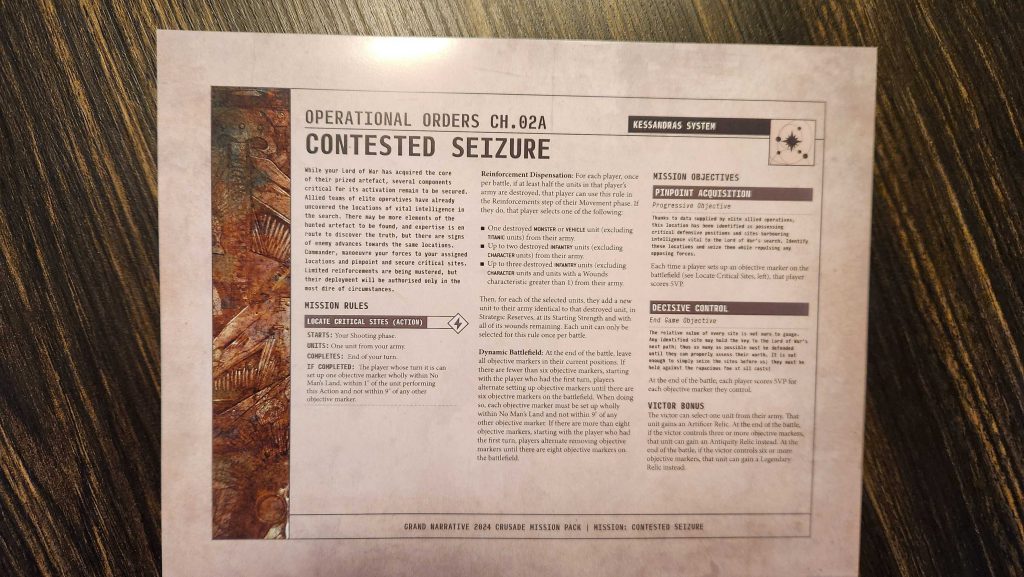
2. Contested Seizure
This is one of two missions in the Grand Narrative pack which have players creating objectives to be kept on the table and used later in the third mission. In this mission both players can perform an action to create an objective marker outside their deployment zones, so long as those are more than 9″ from any other marker, and players score for creating objectives (5 VP per), and holding them at the end of the battle (5 VP per). This mission also has a special catch-up mechanic, Reinforcement Dispensation, which lets players get back dead units once per battle – either three 1-wound infantry units, two multi-wound infantry units, or one non-Titanic monster or vehicle. This is pretty wild given how much units can differ in size and value – getting back ten terminators or six wraiths is an insane amount of value, as is getting back something like a Great Unclean One. Outside of the reinforcements rule, this mission is otherwise fine. The big hook here is that the objective markers you create stay on the battlefield for the next mission.
There was a slightly modified version of this mission for the UK folks, meant to be played earlier in the day – this one was called Critical Path and was largely the same, though with an added rule for giving some units Infiltrators and Stealth.
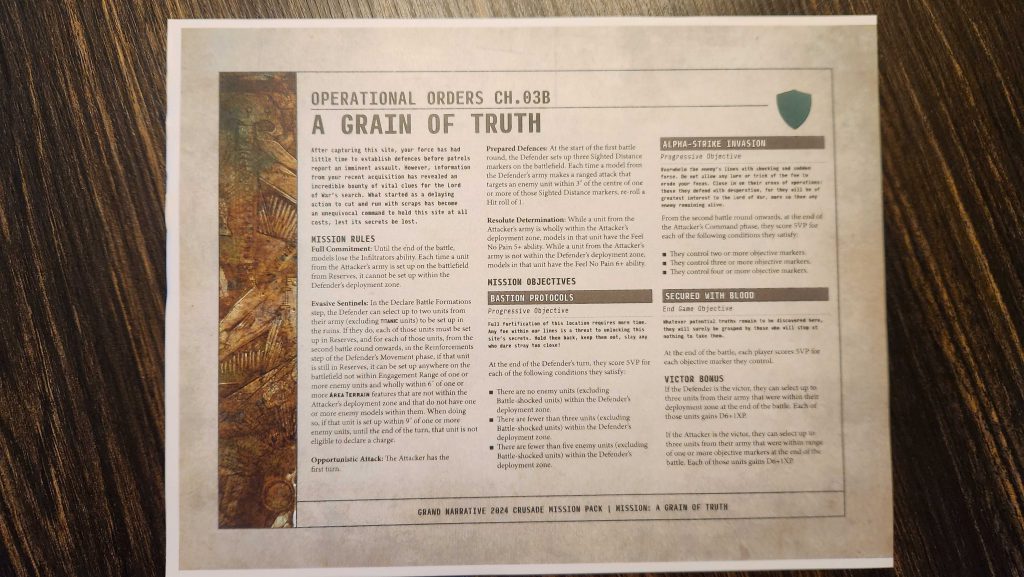
3. A Grain of Truth
Like with Mission 2, this mission had an A/B format depending on which country you were playing in though again, the missions were pretty similar. In this mission the Defender deploys along a narrow diagonal band across the table and cannot Infiltrate. They can however place up to two units from their army “in the ruins,” in which case those units can show up wholly within 6″ of an area terrain feature outside engagement range of an enemy unit and if they show up inside of 9″ they can’t charge.
In this mission the Attacker gets the first turn automatically, which is an insanely dangerous proposition. As some token of balancing the Defender can mark three spots on the battlefield to give units shooting at a target within 3″ of those tokens re-roll 1s to hit. Unfortunately these are placed at the start of the Battle round, so immediately following their placement the Attacker can just move away from them. The Attackers for some reason also get a bonus here – a 5+ Feel No Pain while they’re wholly within their deployment zone, and a 6+ while they’re wholly within the Defender’s deployment zone.
The objectives here are asymmetrical: The Defenders have to keep the Attackers out of their deployment zone while the Attackers need to hold objective markers – the ones placed in the prior round. The Defender gets an early start on scoring, but the Attacker having first turn gives them a solid advantage with regard to denying the defender points on the final turn.
If you’re running this mission – and I wouldn’t recommend running it unmodified, you need to put in some area terrain and make sure you have adequate line-of-sight blocking terrain on the table, set up with the diagonal zones in mind. Being able to deploy knowing that you’ll go first is a huge advantage, and it’s hard to create terrain layouts in a roughly 13″ wide band that hide your units on both sides. When we played this mission at the narrative, this was what we had to work with:
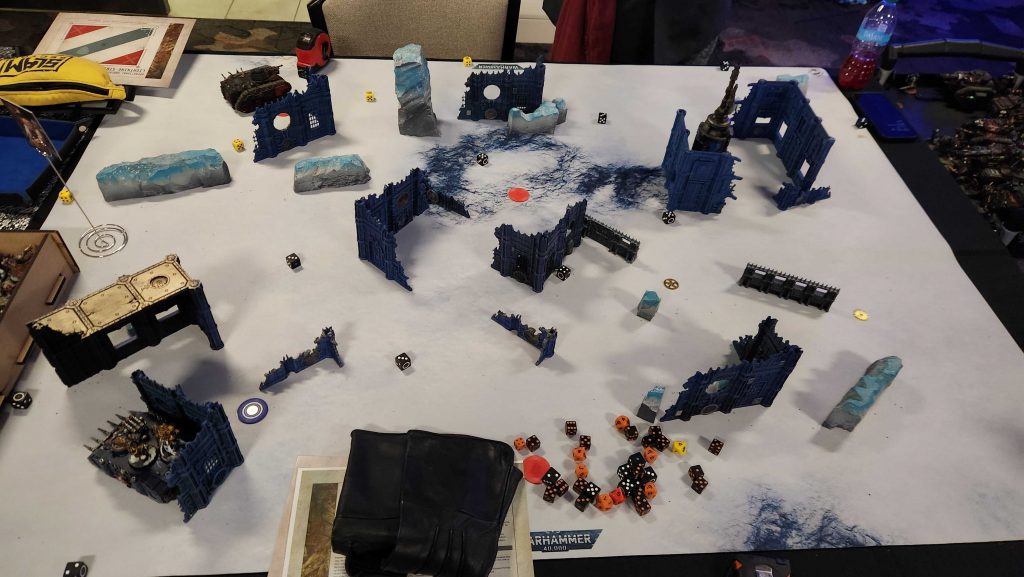
This more or less made turn 1 a shooting gallery, and while I was able to weather the storm by putting a large number of units in transports and Reserves, not everyone was so lucky. Generally speaking, going first isn’t as big a deal if you don’t get to deploy with that knowledge, but if you know you’ll be going first you can make some insane decisions with your deployment that don’t take on any risk – the kinds of decisions that basically remove the ability to play a real, interactive game of 40k.
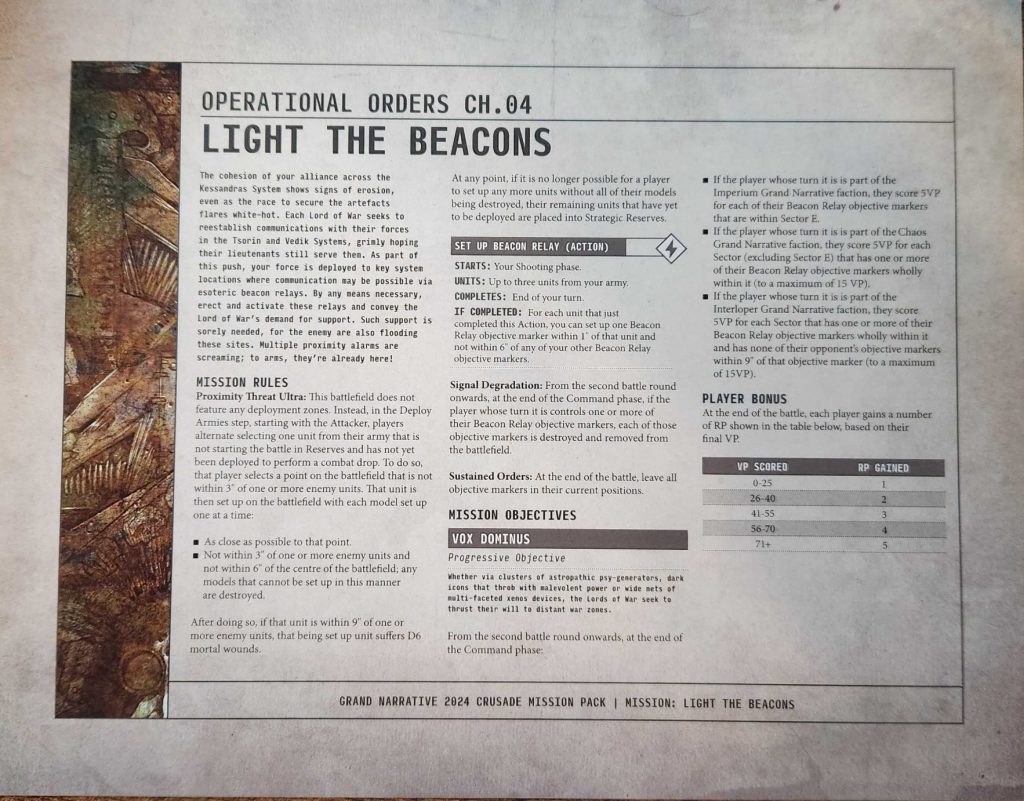
4. Light the Beacons
This is the wildest mission of the bunch and it’s not close. This is another mission where you start on the table with no objectives, place them during the game, and then they stick around after the game is over. What makes this mission particularly crazy however is the deployment map: There are no deployment zones. Instead, players alternate placing units on the table more than 6″ away from the battlefield center and more than 3″ from enemy units. If a unit gets placed within 9″ of an enemy unit, it takes D6 mortal wounds.
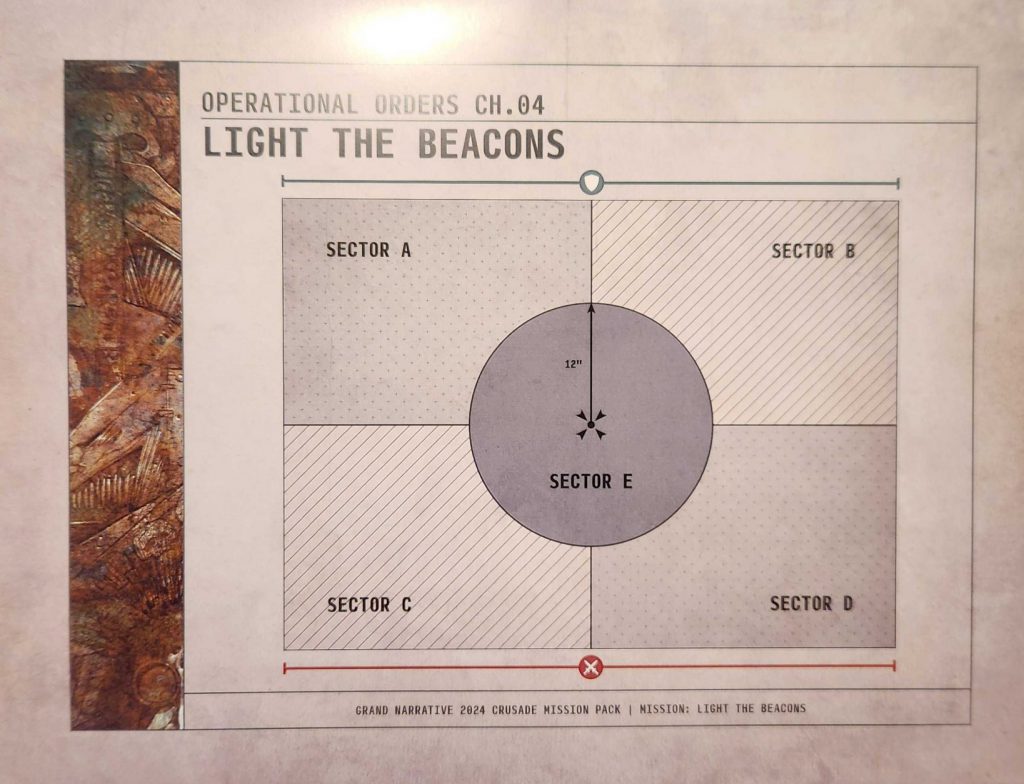
This is more or less designed to mirror the old rules for deep strike but it’s a bit too complex and it needs something like scatter dice mechanics to really execute properly, since deploying in a 3″ circle while staying away from an enemy unit is pretty easy. Once your units are down, your units (up to e per turn) can do an action to create an objective marker, so long as it’s more than 6″ from any other marker you control. If you control a marker created by your opponent in the Command phase you destroy it, and players score VP for having their markers on the table – Chaos scores 5 VP each for having markers in each corner sector with a marker (max 15 VP), the Imperium scores for markers within Sector E (no max), and Interlopers score 5 VP each for a sector which has one of their markers wholly within it and and none of their opponent’s markers within 9″ (max 15). Why the Imperium players have no max here is beyond me – their markers only have to be “within” Sector E, which gives them the ability to drop something like 10 markers if they work around the edges of their circle and place one in the center.
This mission is the most interesting one of the event. I feel like the deployment concept is really cool but also just incredibly broken to the point that it needs a rework. Because of how alternating deployment works there’s very little ability to screen units, as you need to build a screen before dropping some key unit, and with opponents able to drop melee units just outside engagement range and then charge you turn 1 can make for quite a few games that end on the first turn. I think I’d have rather seen this done with some kind of blip/target placement that then leads to alternating deployment on the selected points.
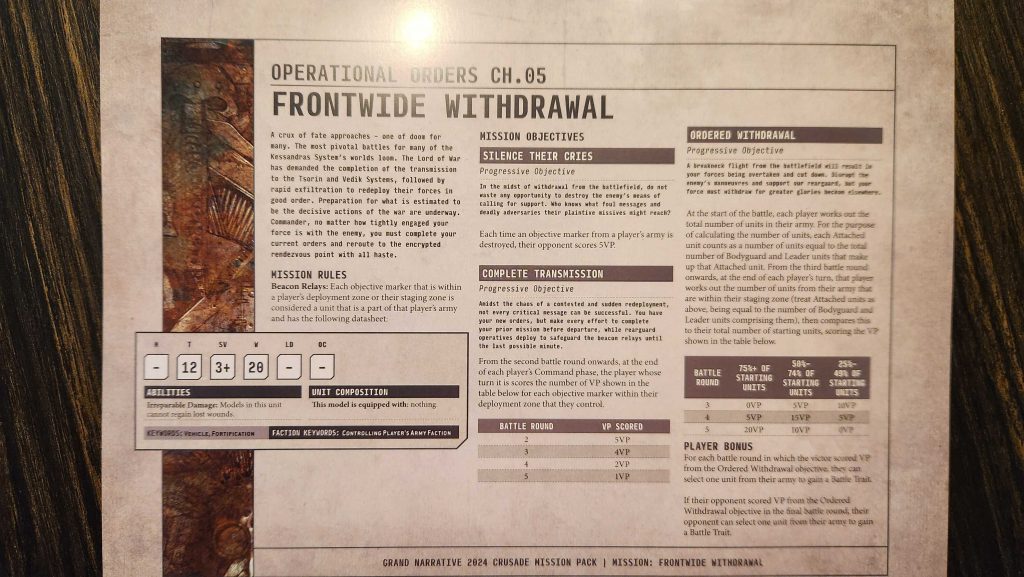
5. Frontwide Withdrawal
In this mission players deploy in narrow bands across the middle of the table – you have two horizontal deployment zones which are 7″ wide, each placed 3″ back from the center of the battlefield, meaning that your units will only be 6″ apart from each other. The beacons left from the last mission now have statlines – T12, 3+ save, 20W, and the ones on your opponent’s side of the table count as enemy units. You have three objectives – destroy your opponent’s objective markers (5 VP each), hold your own (score more for holding them early), and pull your army back into the Staging Zone, the area wholly within 8″ of your long board edge.
This mission is incredibly skewed toward going first – with only 6″ of distance it’s pretty easy to just crash into an enemy’s lines and the limited deployment means there’s no hiding. Yeah, getting your units back into your deployment zone is good but if your enemy is tabled they can’t do that anyways.

6. Terminus Offensive
In the final mission we final have a semi-regular deployment map, albeit with Dawn of War Deployment and zones placed 24″ apart. In this mission there are six objective markers, and you designate your Warlord as a Mission Specialist. During the mission your Mission specialist acts as a Linchpin, increasing the VP you score for holding objectives from 3 to 5 if they’re in the big zone in the middle of the table (a 44″ x 24″ box around the middle of the table). If your Mission Specialist dies, you can nominate a new one at the start of your Movement phase. In addition to scoring 3/5 VP for each objective you control, you’ll score VP for killing enemy units, 5 VP for killing 0-749 points’ worth, 10 for 750-1249, 15 for 1250-1499, and 20 if you kill 1500+ points’ worth.
The big flashy hook on this mission are the faction-specific special rules. Each faction has a special doodad they can activate for a once per game bonus. For the Imperium that’s the Dimensional Tesseract, which lets a unit replace its movement with a teleport that puts them anywhere more than 6″ away from any enemy units – and with no restriction on their ability to charge. For Chaos this gives a single unit’s melee weapons the [DEVASTATING WOUNDS] and [SUSTAINED HITS 2] abilities for a Fight phase. And for Interlopers it’s a 3+ invulnerable save for a unit. Xenos get the short end of the stick here, as that Chaos ability just tears through their 3+ but the Imperium faction get the strongest shout, since Chaos already have good ways to get Dev Wounds and being able to zoom across the table and drop outside of 6″ with a Knight for a charge is just stupid good. Again, I like the idea behind these but they needed a bit more thought.
Final Thoughts
All in all the Grand Narrative rules are interesting and inventive but needed another pass. The traits and relics are wildly powerful, and while that works better for a short event it makes the game super deadly super quick, and that combos with the missions to create problems. The missions also needed another pass and a lot more terrain (and area bases!) on the tables in order to make them workably fun.
Of these I think the first mission has the best design; save the odd retreat order event (I’d just skip that, as it adds nothing), while Contested Seizure and Terminus Offensive feel pretty fine generally. Missions 3, 4, and 5 however just don’t work at all and needed a rewrite, though I like what they were going for with Light the Beacons and feel like it’s worth putting in some work to salvage it. We’ll revisit these missions this weekend in our roundtable discussion about the Narrative and then next Tuesday we’ll come back and talk about how we might adjust these to make them more workable for regular play.
Also if you’re looking to play these missions yourself, we have support for them in Tabletop Battles – check that out here.
Have any questions or feedback? Drop us a note in the comments below or email us at contact@goonhammer.com. Want articles like this linked in your inbox every Monday morning? Sign up for our newsletter. And don’t forget that you can support us on Patreon for backer rewards like early video content, Administratum access, an ad-free experience on our website and more.


